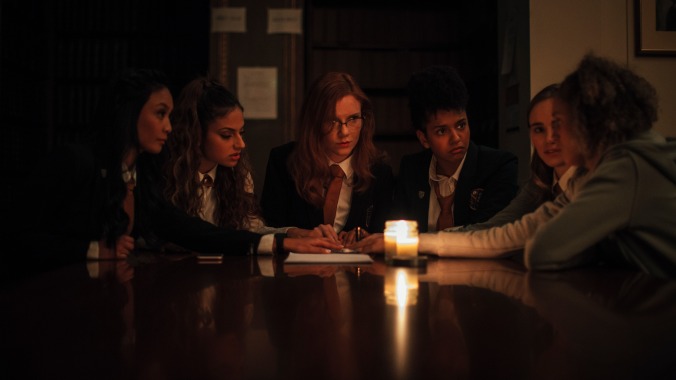The writer of You’re Next holds a Seance in his twisty directorial debut

Combining the relatability of adolescent messiness with the chilly formality of upper-crust manners, a boarding school is an ideal location for a ghost story. That’s not a new observation: The tony confines of an elite residential academy have served as the backdrop for many tales of the uncanny, both classic and otherwise. (Remember Jennifer, the 1978 Carrie rip-off about a bullied girl with telekinetic power over snakes?) It makes sense, then, that Simon Barrett would set his feature directorial debut at the fictional, exclusive Edelvine Academy For Girls. Barrett’s work as a screenwriter on films like You’re Next and The Guest has never revolved around teens, but it has revolved around clever subversions of familiar tropes. Seance carries on that tradition.
It’s hard to shake The CW of it all in the first half, as Camille (Suki Waterhouse), a mysterious young woman with a hazy past and suspiciously fast reflexes, arrives at Edelvine in the wake of a tragedy. A student named Kerrie (Megan Best) recently died after falling out of her dorm room window; the school’s scandal-adverse administration was quick to label the event a suicide, but the student body knows that Kerrie’s demise was the result of a prank gone horribly wrong. That, however, won’t stop a popular clique led by the imperious Alice (Inanna Sarkis) from hazing the new girl, leading to a growing suspicion that the girls’ slumber-party games and incantations they found on the internet have awoken something truly sinister.
Seance was a COVID-era production, and the practical considerations of its shoot are reflected in the enclosed setting—the farthest the camera goes is onto the school’s front lawn—and the lack of extras in the classroom scenes. Much of the film is dimly lit, and brushed with a shade of gunmetal gray frequently associated with luxury condominiums. And while the scares are effectively staged, most of them are too short to really count as symphonies of tension and release. It’s a perfectly serviceable foundation on which to build something surprising—the film’s twists and turns are the most interesting thing about it, but they’re difficult to discuss without getting into spoiler territory. Suffice to say that one of Barrett’s pet themes re-emerges with a vengeance.
The stylized dialogue tumbles out of the characters’ mouths with ease. Many screenwriters-turned-first time directors would place too much emphasis on the turns of phrase, but Barrett makes his quips part of the fabric of the story. That plus is also a minus, however, in the sense that his talent as a writer fades into the background like so many tasteful leather armchairs. Kudos are due to the filmmaker for telling a story about teenage girls that neither condescends to nor oversexualizes them. (Horndogs looking for topless pillow fights should apply elsewhere.) But when it comes to shock and delight, Seance doesn’t quite live up to Barrett’s work with other directors. It’s tough being a legacy.